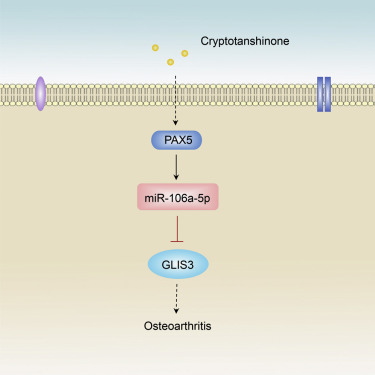Molecular Therapy - Nucleic Acids ( IF 6.5 ) Pub Date : 2018-02-08 , DOI: 10.1016/j.omtn.2018.02.001 Quanbo Ji , Dengbin Qi , Xiaojie Xu , Yameng Xu , Stuart B. Goodman , Lei Kang , Qi Song , Zhongyi Fan , William J. Maloney , Yan Wang

|
Cryptotanshinone (CTS) has emerged as an anti-inflammatory agent in osteoarthritis (OA). However, the molecular mechanism underlying its potent therapeutic effect on OA remains largely unknown. MicroRNAs (miRNAs) act as crucial regulators in maintaining cartilage homeostasis. To investigate whether CTS protects against developing OA through regulation of miRNAs, we examined the potential CTS-mediated miRNA molecules using microarray analysis. We found that CTS significantly promoted miR-106a-5p expression in chondrocytes. Using the OA mouse model created by anterior cruciate ligament transection, we revealed that intra-articular injection of miR-106a-5p agomir attenuated OA. In addition, miR-106a-5p inhibited GLI-similar 3 (GLIS3) production by directly targeting the 3′ untranslated region. CTS promoted miR-106a-5p expression through recruitment of a member of the paired box (PAX) family of transcription factors, PAX5, to the miR-106a-5p promoter. Inhibition of PAX5 mimicked the effect of miR-106a-5p and abolished the CTS ability to regulate miR-106a-5p expression. In OA patients, miR-106-5p is downregulated which is accompanied by downregulation of PAX5 and upregulation of GLIS3. Collectively, these data highlight that the PAX5/miR-106a-5p/GLIS3 axis acts as a novel pleiotropic regulator in CTS-mediated OA cartilage protection, suggesting that miR-106a-5p and PAX5 activation and GLIS3 inhibition might be useful and attractive for therapeutic strategies to treat OA patients.
中文翻译:

隐丹参酮通过miR-106a-5p / GLIS3轴保护软骨免于发展为骨关节炎
隐丹参酮(CTS)已作为骨关节炎(OA)中的消炎药出现。然而,其对OA有效治疗的潜在分子机制仍是未知之数。MicroRNA(miRNA)是维持软骨稳态的关键调节剂。为了研究CTS是否通过调节miRNA来防止OA的发展,我们使用微阵列分析检查了潜在的CTS介导的miRNA分子。我们发现CTS可以显着促进软骨细胞中miR-106a-5p的表达。使用由前交叉韧带横断所创建的OA小鼠模型,我们揭示了miR-106a-5pagomir的关节腔内注射可减轻OA。另外,miR-106a-5p通过直接靶向3'非翻译区来抑制GLI-like 3(GLIS3)的产生。CTS通过将成对盒(PAX)家族转录因子PAX5的成员募集到miR-106a-5p启动子来促进miR-106a-5p表达。对PAX5的抑制作用模仿了miR-106a-5p的作用,并取消了CTS调节miR-106a-5p表达的能力。在OA患者中,miR-106-5p被下调,并伴有PAX5的下调和GLIS3的上调。这些数据共同表明,PAX5 / miR-106a-5p / GLIS3轴可作为CTS介导的OA软骨保护中的新型多效性调节剂,这表明miR-106a-5p和PAX5的激活以及GLIS3的抑制作用可能是有用的,并且对治疗OA患者的治疗策略。对PAX5的抑制作用模仿了miR-106a-5p的作用,并取消了CTS调节miR-106a-5p表达的能力。在OA患者中,miR-106-5p被下调,同时伴随着PAX5的下调和GLIS3的上调。这些数据共同表明,PAX5 / miR-106a-5p / GLIS3轴可作为CTS介导的OA软骨保护中的新型多效性调节剂,这表明miR-106a-5p和PAX5的激活以及GLIS3的抑制作用可能是有用的,并且对治疗OA患者的治疗策略。对PAX5的抑制作用模仿了miR-106a-5p的作用,并取消了CTS调节miR-106a-5p表达的能力。在OA患者中,miR-106-5p被下调,并伴有PAX5的下调和GLIS3的上调。这些数据共同表明,PAX5 / miR-106a-5p / GLIS3轴可作为CTS介导的OA软骨保护中的新型多效性调节剂,这表明miR-106a-5p和PAX5的激活以及GLIS3的抑制作用可能是有用的,并且对治疗OA患者的治疗策略。











































 京公网安备 11010802027423号
京公网安备 11010802027423号